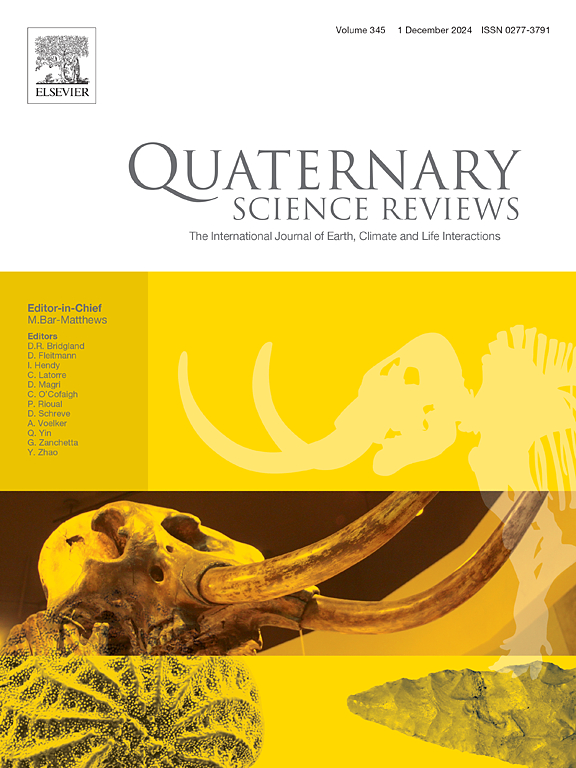Vulnerability of montane forests of Cameroon in the face of climate change: Insight from the last glacial-interglacial transition
IF 3.3
1区 地球科学
Q1 GEOGRAPHY, PHYSICAL
引用次数: 0
Abstract
Aim
Afromontane forests of Cameroon are part of the West Africa Biodiversity Hotspot. Often located within or on the fringes of densely populated regions, they are currently highly threatened by the combined effect of climate change and of anthropogenic pressure. In order to provide bases for their conservation and management this article aims at studying the turnover of species and in particular the behavior of Podocarpus milanjianus/latifolius during the last glacial-interglacial transition, a period characterized by dramatic shifts in climatic conditions.
Location
Cameroon highlands, Lake Bambili, Lake Mbi, Lake Child and Lake Monoun.
Methods
Pollen analyses.
Results
The expansion of the post-glacial Afromontane forest took place in two main stages, coinciding with periods of increased precipitation. The first phase of development dates back to 14.5 ka. It was interrupted by the dry event of the Younger Dryas (YD) starting at 12.5 ka. The Afromontane forest then resumed its expansion from 11.5 ka, reaching its optimum between 9.8 and 8.5 ka. This was characterized by the massive expansion of Podocarpus in the northern sector of the Cameroon Volcanic Line (CVL) (Bambili, Mbi, Monoun). In the southern sector, closer to the coast, on the other hand, Afromontane forest elements declined in favor of sub-montane elements during the Holocene (Child).
Main conclusions
(i) Podocarpus experienced significant changes in abundance/extent within the current Afromontane forest belt during the post-glacial forest transgression. It was a fast colonizer in open and floristically poorly diverse areas where it benefited from the absence of competitors. In contrast, it has been a weak competitor within the Afromontane forest itself compared to more dynamic and fast dispersing tree taxa. (ii) The forest optimum was reached during the early Holocene, after a long period of gradual forest expansion characterized by a high turnover of species; (iii) Migration and stabilization times of the forest environment can be evaluated in centuries, even millennia, that has important implication for forest management.
面对气候变化,喀麦隆山地森林的脆弱性:从末次冰期-间冰期过渡的洞察
喀麦隆的山地森林是西非生物多样性热点的一部分。它们通常位于人口稠密地区的内部或边缘,目前受到气候变化和人为压力的综合影响的高度威胁。本文旨在研究末次冰期-间冰期气候条件剧烈变化时期的物种更替,特别是milanjianus/latifolius的行为,为其保护和管理提供依据。喀麦隆高地,班比利湖,姆比湖,柴尔德湖和莫诺湖。MethodsPollen分析。结果冰期后非洲山地森林的扩张分为两个主要阶段,与降水增加的时期相吻合。第一阶段的发展可以追溯到14.5 ka。它被12.5 ka开始的新仙女木期(YD)的干燥事件所中断。从11.5 ka开始,非洲山地森林恢复扩张,在9.8 ~ 8.5 ka之间达到最高峰。其特点是喀麦隆火山线(CVL)北段(班比利、姆比、莫诺恩)的Podocarpus大规模扩张。另一方面,在靠近海岸的南部地区,全新世以来非洲山地森林元素逐渐减少,取而代之的是亚山地元素。主要结论(1)冰期后森林海侵期间,非洲山地森林带内Podocarpus的丰度/范围发生了显著变化。在开放和植物多样性差的地区,它是一个快速的殖民者,在那里它受益于缺乏竞争对手。相比之下,与更具活力和快速分散的树木类群相比,它在非洲山区森林本身一直是一个弱竞争者。(ii)在全新世早期,经过长时间的以物种高更替为特征的森林逐渐扩张,达到了森林的最佳状态;森林环境的迁移和稳定时间可以用几个世纪甚至几千年来评价,这对森林管理具有重要意义。
本文章由计算机程序翻译,如有差异,请以英文原文为准。
求助全文
约1分钟内获得全文
求助全文
来源期刊

Quaternary Science Reviews
地学-地球科学综合
CiteScore
7.50
自引率
15.00%
发文量
388
审稿时长
3 months
期刊介绍:
Quaternary Science Reviews caters for all aspects of Quaternary science, and includes, for example, geology, geomorphology, geography, archaeology, soil science, palaeobotany, palaeontology, palaeoclimatology and the full range of applicable dating methods. The dividing line between what constitutes the review paper and one which contains new original data is not easy to establish, so QSR also publishes papers with new data especially if these perform a review function. All the Quaternary sciences are changing rapidly and subject to re-evaluation as the pace of discovery quickens; thus the diverse but comprehensive role of Quaternary Science Reviews keeps readers abreast of the wider issues relating to new developments in the field.
 求助内容:
求助内容: 应助结果提醒方式:
应助结果提醒方式:


